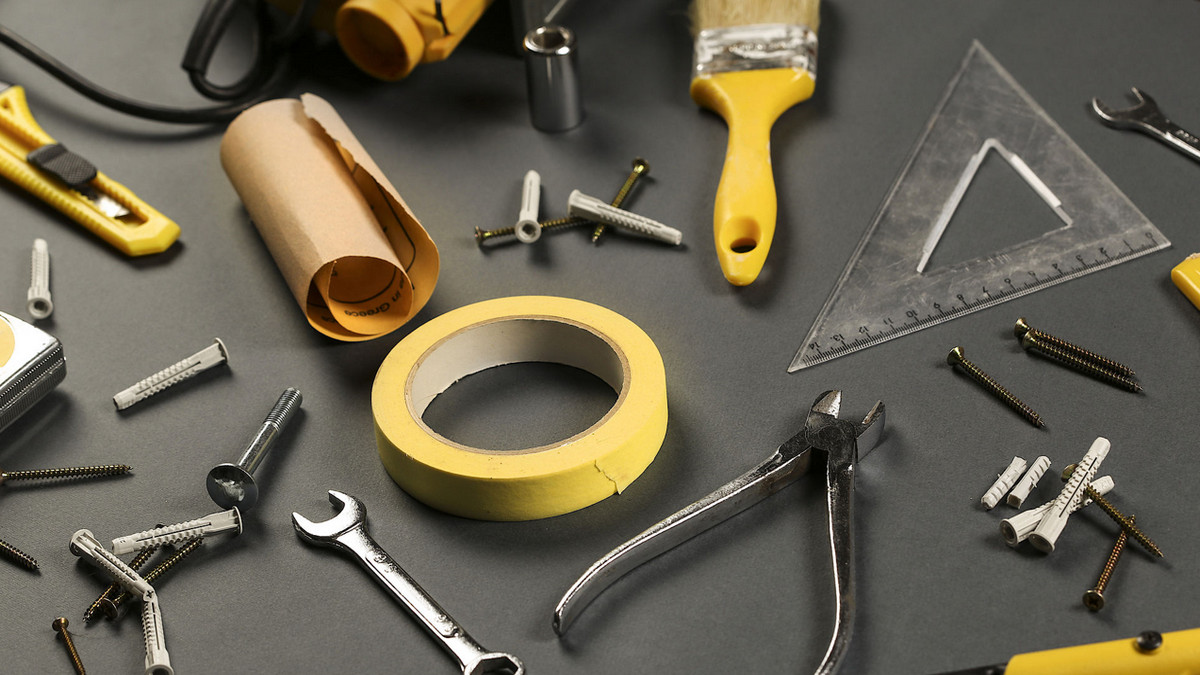A hand tool is any tool that uses hand force or twisting to power the tool, by rather than one powered by a motor. There are a variety of hand tools including screwdrivers, wrenches, hammers and much more! Let’s find out!
Structure
Hand tools can be divided into wrenches, pliers, screwdrivers, tape measures, hammers, sockets, cutters, scissors, and auxiliary tools such as tool carts, etc. Each category has a variety of different models.
Wrenches include open-end wrenches, socket wrenches, ratchet wrenches (quick wrenches), dual-purpose wrenches (composite wrenches), tubing wrenches, T-socket wrenches, cross-socket wrenches, adjustable wrenches and other categories.
Pliers include wire pliers, needle nose pliers, diagonal nose pliers, retaining ring pliers, carp pliers, water pump pliers, pipe pliers, strong pliers and other categories;
Cutting tools include files, diamond files, iron scissors, aviation scissors, utility knives, square pipe saws, pipe cutters, bolt cutters and other categories.
Classification
Screwdriver
A tool used to turn a screw to force it into place, usually with a thin wedge-shaped head that fits into a slot or notch in the head of the screw, also known as a "driver". Besides the most common “-“ and “+” tips, screwdrivers may have patterned or other specially shaped tips.
Wrench
Hand tools for turning bolts, screws, nuts, and other threaded fasteners. The wrench is usually provided with a clamping handle at one or both ends of the handle to apply external force to the handle to rotate the bolt or nut.
Hammer
A tool that knocks an object to move or deform it. Most commonly used to drive nails, or straighten or knock objects apart. Hammers come in a variety of forms, the most common being a handle and a head. One side of the head is flat for striking and the other side is the hammer face. “Claw” hammers have a head with the back shaped like a claw or wedge which is used to pull out nails. There are also hammers with rounded heads, fitter hammers, rubber hammers, and installation hammers.
Test Pen
Also referred to as "electric pen". It is an electrician's tool used to test whether there is electricity in a wire or electric outlet. There is a neon bulb in the pen body. If the neon bulb glows when touching the wire or electric outlet, it means that the wire has electricity, or it is the live wire of the outlet. The nib and tail of the test pen are made of metal material, and the pen holder is made of insulating material. When using the test pen, be sure to touch the metal part at the end of the test pen with your hands, otherwise, a complete circuit will not be formed from the charged body, through the test pen, and then through your body to the ground. If the circuit is not complete, the neon light in the test pen will not emit light, resulting in misjudgment that the charged body is not charged.
Tape Measure
The most commonly used tape measure is the steel tape measure, commonly used in construction and decoration. They are a must-have tool for any family. Other types of ape measures are fiber tape measures and waist circumference measure, etc.
Wallpaper Knife
A type of knife with a sharp blade used to cut things like wallpaper, hence the name "wallpaper knife. It is also known as a "utility knife". They are often used when putting up decorations, or advertisements etc.
Electrician’s Knife
An electrician's knife is a cutting tool commonly used by electricians. The ordinary electric knife is composed of a blade, a handle, and a knife hanger. When not in use, retract the blade into the handle. The root of the blade is hinged with the handle which has scale marks on it. The front end is formed with a screwdriver bit, and the two sides have a file surface area. There is a protection button on the handle to prevent the blade from being ejected. The blades of the electrician's knife have multiple functions so can be used to complete various operations of connecting wires without carrying other tools. It has the benefits of a simple structure, is convenient for use, and has multiple functions.
Saws
These including hand saws (household, woodworking), cutting saws (branch trimming), folding saws (branch trimming), hand hacksaws, edge saws (woodworking), slitting saws (woodworking), cross-cut saws (woodworking), etc.
Level
The spirit level has a level bubble, which can be used for inspection, measurement, and determining whether equipment is installed levelly.
Wire Cutters
The wire cutter is a clamp and cutting tool, which consists of a plier head and a plier handle. The functions of each part of the pliers are:
- The tooth gap can be used to tighten or loosen nuts.
- The knife edge can be used to cut the rubber or plastic insulating layer of the flexible wire, and can also be used to cut the wire.
- The wire cutter can be used to cut hard metal wires such as steel wires.
- The insulating plastic tube of the pliers can withstand voltage of more than 500V, so can be used to cut wires with electricity.
Needle Nose Pliers
Also called trimming pliers, it is mainly used to cut single-strand and multi-strand wires with thinner wire diameters, as well as bending the wire joints of single-strand wires. It is also commonly used by electricians (especially interior electricians). It is composed of a pointed tip, a knife edge and a plier handle. The handle of the electrician's needle-nose pliers is covered with an insulating sleeve with a rated voltage of 500V.
Wire Stripper
The wire stripper is one of the tools commonly used by electricians, motor mechanics, and instrumentation electricians. It is composed of a knife edge, a crimping port and a plier handle. The handle of the wire stripper is covered with an insulating sleeve with a rated working voltage of 500V. The wire stripper is suitable for stripping plastic and rubber insulated wires and cable core wires. The wire end to be stripped off is placed in the cutting edge of the plier head. When the plier handles are closed insulation on the wire will be separated from the core wire.
Tool Operation
Hack saws
- Select the appropriate saw blade according to the work, for example: 14 teeth per inch for sawing solid or thick soft metals; 18 teeth per inch for tool steel, iron pipes, hard metals, etc.; and 24 teeth per inch for metal Sawing of plates, metal pipes, thin iron bars.
- Push the saw forward and lift slightly as you pull back.
Wrenches
- An appropriate size wrench should be selected according to the nature of the work.
- When using an adjustable wrench, apply force to the fixed side, never to the movable side.
- If the opening of the wrench is worn or slips during use, do not continue to use it to avoid slippage.
- Do not use a wrench as a hammer.
- Do not put a pipe on the handle end of the wrench to increase the torque of the wrench.
Long Squares
Press the inside of the first side of the square, lean against the edge of the board, and draw a pencil along the inside of the second side of the square to draw a vertical line.
Screwdrivers
- The size and shape of the groove of the screw head should be matched, and an appropriate screwdriver should be selected.
- The handle of the screwdriver should not be struck with a hammer. If the handle is damaged, it should be replaced immediately.
- Do not use the screwdriver as a chisel or lever.
- Use an electric screwdriver to test the current, and do not use a general screwdriver to test high voltage.
- The blade of the screwdriver should not be ground, so as not to damage the hardened surface.
- The screwdriver should not be put in the pockets of clothes or trousers to avoid injury when bumping or falling.
C-Clamps
C-type clips are used to fix work objects. When clamping, the shaft rocker is facing down. Generally, 3-inch clips or 4-inch clips (refer to the maximum thickness that can be clamped) can be used, depending on the number of clips.
Pliers
- Pliers are only used to fasten, insert and remove various pins, nails, and cut or twist various wires.
- Pliers should not be used to tighten or tap bolts or nuts.
- Do not tap or lengthen the handle at the pliers handle to increase the clamping or cutting force.
Woodworking Knives
Woodworking knives are generally used for trimming irregular parts of details, and the blade is a whole piece that is not easy to break.
Safety Precautions
Hazards caused by common hand tools include:
- Cuts by sharp parts.
- Getting stabbed by a sharp part.
- Getting caught by a tool.
- Injuring the hand while hammering.
- Injured by flying debris from work.
- Affected by the noise generated during work.
- Inhaling dust generated during work.
Precautions
- Before use, hand tools must be inspected for damage. Unsafe tools should not be used.
- Keep the tool clean, especially the grip part of the tool, so as to prevent slippery hands from slipping off during work.
- Wear appropriate personal protective equipment such as goggles, gloves, etc.
- Use hand tools with the correct posture and technique. The posture should be stable and safe, and do not use excessive force.
- When using sharp tools, do not point the blade or sharp part towards others.
- When not in use, the tool should be protected by wrapping the blade or sharp part with a shield, and avoid carrying the tool by hand or putting it in the pocket.
- Do not misuse hand tools for other purposes.
- Understand the characteristics of each hand tool and use it correctly.









.png)




